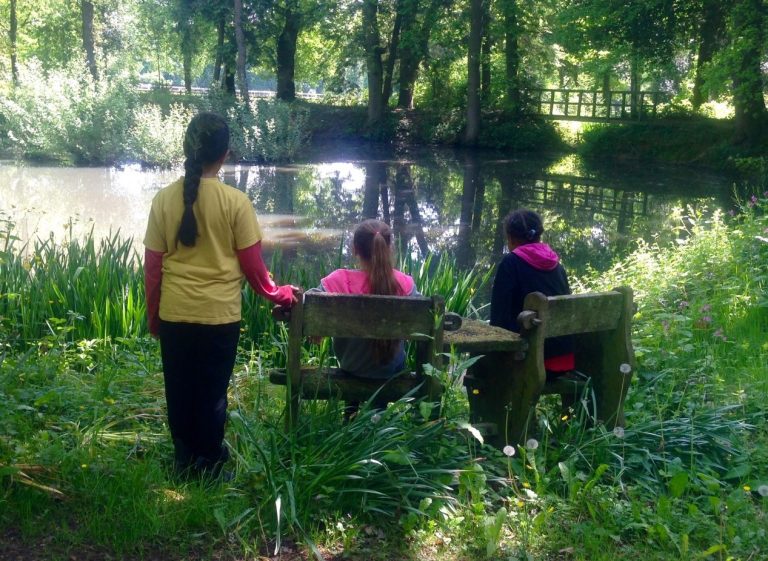Wow, what a month. What wonderful and, for gardeners, awful weather. But today it is raining! It reminds me of the Summer holiday weather of my childhood, a long time ago now. It used to seem so dreary. Now I am a gardener it is beautiful – and the trees are loving it and breathing a long sigh of relief.
We struggled a bit but we have lost very little in the heat. One new Tulip tree (Liriodendron tulipifera) has gone and two young Liquidambars look decidedly dodgy. But so far that’s it. And the Hydrangeas, which are so prone to wilt – and die – with lack of rain have survived – with some help from our water bowser, which is a saviour, on the one hand, but deploying it, on the other, is one of the worst Summer jobs – and they look magnificent. Better than ever. Lacecaps, Mop-heads, Paniculatas, Asperas all of which are doing well, except the Asperas, I suppose, which we really haven’t mastered yet. The colours are splendid and last for weeks and even when they are fading they fade through so many different colours and they’re still attractive through the Winter.
But the star of the show this week and next is the big Silver Pendant Lime (Tilia tomentosa “Petiolaris”). The scent from its flowers is perhaps my favourite smell and I can smell it now while I write this note 300 or 400 yards away! And, I’m not the only person who loves it. A couple of days ago when I went to look at it it was covered with bees and huge numbers of other insects. The whole tree was humming. The honey is meant to be superb but I haven’t managed to find anyone nearby who will help me with some bee-hives which we would like to put near our large Lime trees. They are amongst the largest trees we have. But how do they stand up? The wood of a Lime tree is as soft as butter. One of the main reasons why the great English sculptor and wood-carver, Grinling Gibbons, in the late 17th Century and early 18th Century, often carved Lime wood for his staircases and reliefs. You could carve it with a spoon.
Having checked out the Silver Pendent Lime, I then went to see some Rowan trees (Sorbus aucuparia), which I planted in memory of a friend who died young – if you can call my age young, that is. Its berries are just turning a beautiful red and will be enjoyed by the birds later in the year.
Talking about berries, I also stopped off for my first handful of Blackerries this year. Delicious, if on the small side. This rain will bring them on though.
Nearby, three Indian Bean Trees (Catalpa bignonioides) are flowering for the first time – we planted them seven or eight years ago. The flowers are not unlike a slightly squashed and frilly Chestnut flower or candle: white, purple stripes going to solid purple as the flowers die and a couple of elegant orange stripes, as well; stunning to look at from a distance and close up. The resulting fruit – long, narrow bean pods, hence the colloquial name – last through Winter and Spring. Btw, this tree is native to the southeastern United States. Those Indians, not the other Indian(!), who are represented nearby by a tree known as the Pride of India (Koelreuteria paniculata), although I’ve seen huge numbers in China but none yet in India!


This time of year is marked by mowing. We now leave all the grass in the Woods to be mowed now, when the Bluebells have seeded and the grass has seeded and as many of the wild flowers as possible have grown wildly and also seeded, and have provided the best possible environment for wildlife, including birds, butterflies, insects, frogs and toads etc etc and also for me. I love the look of the grass at this time of year. It looks like a savannah – with a different personality from the rest of the year – and is full of interesting plants and flowers, only half of which I can name or remember. Time to get Toby Hart back to do another seminar/walk in the woods for us.
Finally, one sour note, unfortunately. I was walking in the Woods last week and was amazed to see a Cherry plum tree (Prunus cerasifera) not just bearing fruit for the first time but covered with the most beautiful deep red plums. An unexpected and beautiful sight. Although a deep red the fruit was still hard. So, I left the tree until this week, when I saw that ALL the fruit had gone, save for two wasp-eaten plums. All taken by someone wandering in our Woods. We let a lot of people walk in the Woods and a lot of people enjoy them as much as we do. So, it is shocking when something like this happens.

Toby Greenbury, very much in his happy place, aboard his AS 940 Sherpa – a cross between a go-cart and a Lamborghini (so we are told).

